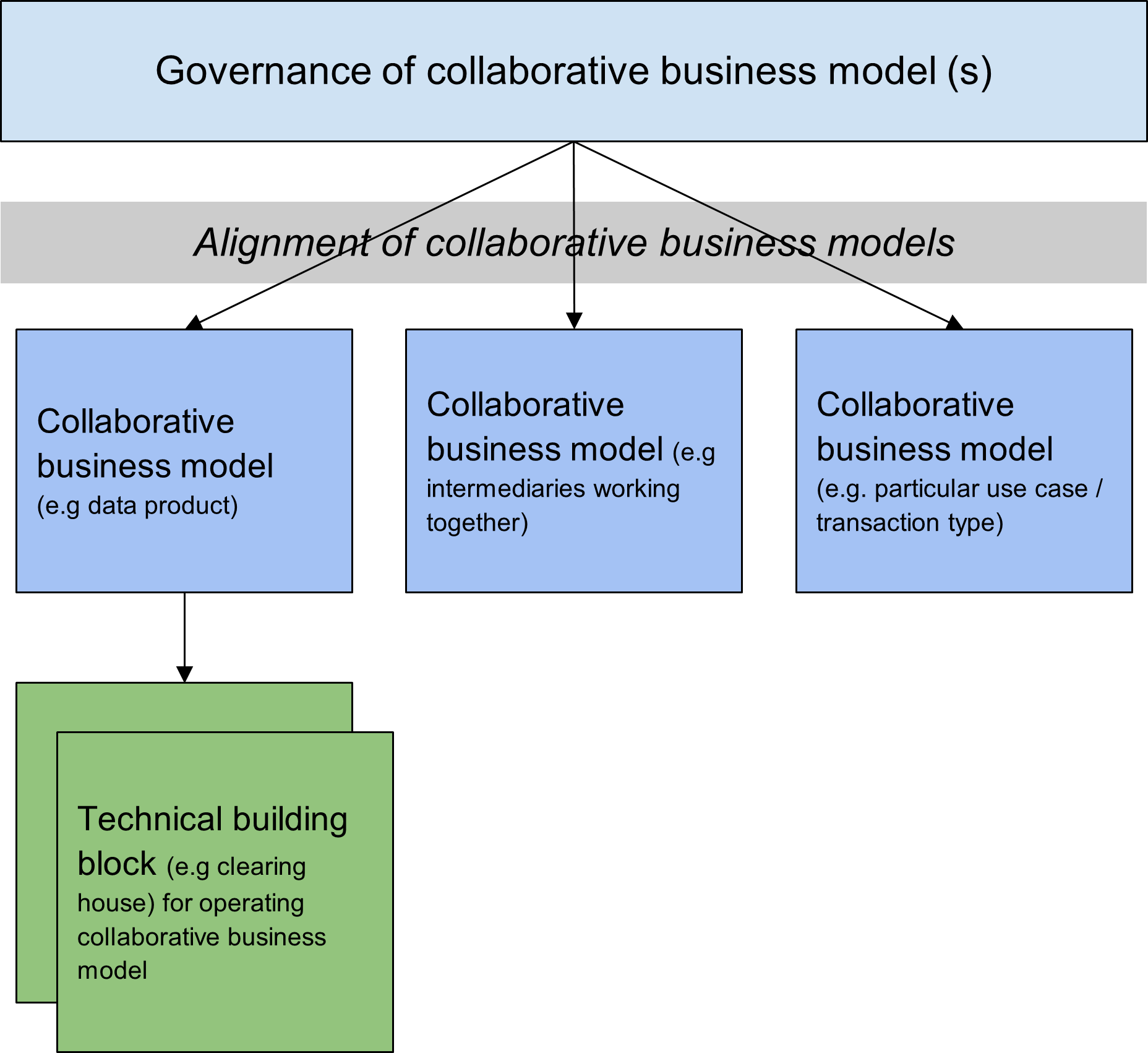FOR SHARE - JULY SNAPSHOT - 20230622 Draft Collaborative Business Models - snippet
Early draft
Please be aware that the Data Spaces Blueprint content shared in these pages are a very early draft published on 2023-07-01. The current draft is incomplete and the content might still change.
SAVE-THE-DATE 01-10/09/2023: We will welcome your feedbacks to future improve the Data Spaces Blueprint during the Public consultation that will open on September the 1st 2023 until September the 10th. Please mark these dates in your calendar and get ready!
Draft building block snippet: The Collaborative Business Models of the Data Space
Overview
In the data space context, collaborative business models refer to the business models that consider the objectives and interests of all involved stakeholders that co-create and distribute value jointly through data exchange and its monetization.
A set of collaborative business models that are developed around a set of stakeholder roles, intermediaries, data products or use cases jointly define the business models of the data space. They together ensure that the financial objectives of the data space are met, and the data space is sustainable.
We distinguish between the individual collaborative business models of the data space (that are specific to a set of use cases, a set of data products, a set of stakeholder roles, or a set of intermediaries), their alignment, and their governance. The governance of the collaborative business model(s) refers to the development and enforcement of a set of rules concerning the business strategy of the data space. The governance of the collaborative business models is part of the governance framework of the data space. The coordination and alignment of the individual collaborative business models ensures that the design and implementation of individual collaborative business models comply with the rules set in the governance framework. The collaborative business models set some of the requirements for the technical building blocks, while the technical building blocks enable or facilitate the functions of the collaborative business models.
The relationship between these concepts are visualized in Figure 1.
Figure 1. Collaborative business models, their alignment and governance
Key elements
The individual collaborative business models have the following elements (not necessarily all):
Type: We distinguish between the following types of collaborative business models:
Collaborative business models for a set of stakeholder roles
Collaborative business models for intermediaries
Collaborative business models for a set of data products
Collaborative business models for a set of use cases
Scope: the boundaries of the business model that the particular business model refers to (e.g., the whole data space, a set of use cases, a set of data products, a set of intermediaries).
Stakeholder roles: the roles involved within the scope of the collaborative business model (e.g., a set of data providers, data receivers, data users)
Use cases: the set of use cases involved within the scope of the collaborative business model.
Data Intermediaries: the set of data intermediaries within the scope of the collaborative business model.
Data products: the set of data products within the scope of the collaborative business model.
Customers: the existing and potential customers to whom the service is, or will be provided.
Value proposition/ service: The characteristics of the offering that the data space provides within the scope of the business model. The value proposition can have several different dimensions, such as operational, social, functional, strategic, symbolic, etc.
Revenue model / Monetary value network: a network consisting of several value exchange paths specified in form of roles (i.e., nodes in a network) and the relationships between these stakeholder roles (i.e., associations between the nodes). The relationship could be (1) one-directional (provider->receiver), or bidirectional, (2) mandatory or optional as well as (3) direct or indirect. The relationship is characterized with a description of the revenue logic between the nodes (e.g., revenue share, subscription-based or usage-based revenue model).
Cost structure: the cost factors associated with creating, delivering and capturing the value within the scope of a business model.
The key elements of the Governance of the Collaborative Business Model(s) concern the business strategy and the growth strategy of the data space. These are described as part of the Governance Framework building block.
Key functions
Individual collaborative business models have the following functions:
Characterize the different type of value exchange within the scope of the business model.
Identify the value for each stakeholder and the related role within the scope of a business model that the data space provides.
Ensures that the value is fairly distributed among the stakeholders holding the roles within the scope of the business model.
The Governance of the Collaborative Business Model(s) are out of the scope of this document. However, these have the following main functions:
Ensures that the financial objectives are met.
Ensures the economic sustainability of the data space.
Ensures the growth and scaling of the data space.
Dependencies and relationships
This building block is closely related to the data products, use case accelerator, and data intermediaries building blocks. Depending on its type, the business model can concern data transactions around a set of data products, a set of use cases, or a set of intermediaries.
The governance framework sets the requirements for this building block, while this building block ensures that the objectives of the governance are fulfilled.
As already mentioned in the overview, the collaborative business models set some of the requirements for the technical building blocks, while the technical building blocks enable or facilitate the functions of the collaborative business models.
Relevance for the data space
Collaborative business models are crucial for the adoption and sustainability of the data spaces. Paying attention to collaborative business models is important also from an ethical perspective to ensure a fair distribution of value.
